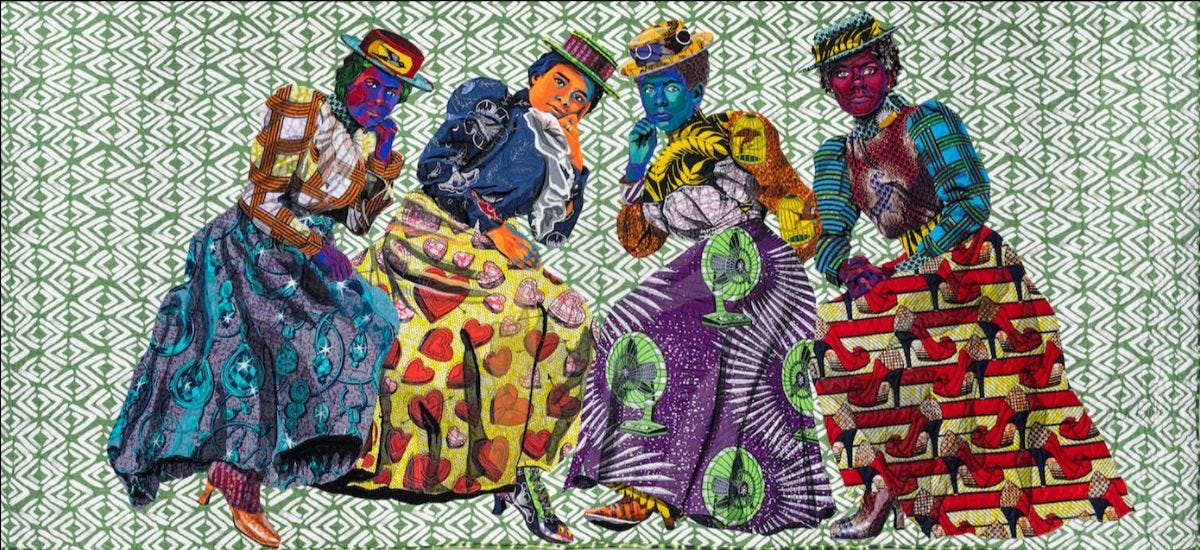Artful Advent 3: Rejoicing in Color
Color is an easy entryway to joy - taking us somewhere deep, under the surface and beyond words
This four-week series explores how parents of little children can nourish themselves in a busy season by looking at their lives like art.
Hello friend,
The third week of Advent is all about joy.
There can be so much joy in parenting. These little people are such delights. Recently, my toddler announced at the dinner table: “Mama, I’m not a chicken, I’m a child.” I mean, come on.
But there’s a deeper joy as a parent, that is present even when delight is not. This joy is tied up with the bonds of love we share with these children in our care.
When I try to visualize joy, I picture saturated colors: sunny yellow, vibrant turquoise, la vie en rose. Color can be such an easy entryway to joy. Like Proust's madeleine, color can quickly take us somewhere deep, under the surface and beyond words.
This becomes helpful when joy feels just out of reach.
Bisa Butler rejoices in color.
Butler is an American textile artist who uses quilting as a medium to create vibrant, life-sized portraits. She bases her artworks on photographs, with subjects ranging from family members, famous Black leaders and thinkers, and unidentified Black Americans from documentary photographs in the National Archives. Her quilted portraits imbue her subjects with dignity and humanity.
Butler’s bold use of color has roots in her training at Howard University, where her art professors challenged her to think about using color with intention. Students were encouraged to experiment, such as by using blank canvases that were black rather than white, and by replacing the beaux-arts color palette with colors inspired by West African fabrics, called Kool-Aid colors.
Butler uses color to create meaning and give life to her subjects, but also to participate in making something new, something uniquely African American.

The life of her art also comes from her story as an artist.
Butler was trained as a painter. But when she became pregnant, the smell of her paints made her sick. And after her baby was born, it became clear that being a mom without a babysitter was not compatible with pointy paintbrushes, sharp painting knives, and toxic paint chemicals.
She thought she wouldn't be able to make art anymore.
But then she had an epiphany. As part of an art education graduate program, she was required to take a fibers class. She walked into the textile room, which was full of sunlight and soft materials, and it was a sort of homecoming. Her fellow students were mostly women, which sharply contrasted with her painting classes. Butler felt comforted by this feminine energy and community, including the connection with women from past generations who would sit in circles to sew collective quilts. It became clear that this was her medium.
She came into her own as an artist, through resilience and talent. She found a way to balance creative work and mothering.
Your invitation this week is to keep your eyes open to the colors around you.
Let yourself marinate in the colors that call out to you, and let that pleasure be a door to joy.
I’ve been looking closely at the colors around me as I’ve navigated a stressful few weeks. Due to a series of unfortunate events, we've had an unexpected month without childcare. A month that was supposed to be used to finish my dissertation proposal. And it’s been hard to pivot from that to this.
The present moment is not always the softest place to land.
So I have been looking at the colors around me—slushy snow whites, matte evergreens, shiny berry reds—and finding pleasure. It feels like giving myself a little hug.
In her book Self-Compassion, Dr. Kristin Neff defines three core elements of self-compassion: common humanity ("All humans feel suffering"), mindfulness ("This is what suffering feels like"), and self-kindness ("I will take care of myself in my suffering"). Looking at color feels like self-kindness. This practice is such an immediate way to self-soothe, to switch tracks from anxiety to connection.
Instead of getting lost in thoughts about where I wish I could be, I come back to where I actually am, and I find goodness there.
And by entering into what is in front of us, rather than fighting against it, we open ourselves up to finding life within the constraints of our season. Like Bisa Butler accepting that painting was not viable as a young mom and discovering a passion for textiles, we too can feel our way to new art forms.
I don’t have a big epiphany moment to share about how looking at the colors around me has replaced suffering with rejoicing. It’s more like a million little moments of feeling lost and looking up.
It goes:
That green is beautiful.
Oh, I remember how to feel pleasure.
I feel held. I feel safe. Even here.
I hope this practice helps to take off some of the pressure to feel nonstop cheer in the MOST JOYFUL TIME OF THE YEAR. No, this kind of joy is deeper and less performative. It is strong enough to co-exist with darkness.
It is such a joy to go through Advent with you. I love hearing your stories; if you’d like to share about your experiences with looking at your life like art, just hit reply to this email. Or if you share on Instagram, you can use the hashtag #LookingAtLifeLikeArt.
This week, in the midst of the ordinary and the chaotic, may the colors around you be portals to access the deep and bubbly joy that is woven into your life as a parent. May the colors soothe, inspire, and delight you.
Wishing you a colorful week,








